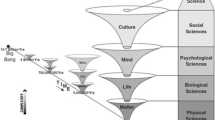Abstract
This paper is an empirical exploration of a new approach to understanding how organisms develop selective and organized behavioral interactions with differing environments. By investigating mutually dependent “interbehavioral” transactions between individuals and environments, need exists for reformulating “reinforcement,” “learning,” and “motivation” conceptions and replacing them with parametric specifications of particular organismic, spatial, temporal, and historical variable configurations. Only such a “systems” analysis will suffice for future theoretical progress.
Similar content being viewed by others
References
BAENNINGER, I. P. 1967. Comparisons of behavioural development in socially isolated and grouped rats, Animal Behaviour, 15, 312–323.
BARKER, R. G. (Ed.) 1963. The stream of behavior. New York: Appleton-Century-Crofts.
BARKER, R. G. 1968. Ecological psychology. Stanford: Stanford University Press.
BINDRA, D., & BLOND, J. 1958. A time-sample method for measuring general activity and its components, Canadian Journal of Psychology, 12, 74–76.
BOLLES, R. C. 1970. Species-specific defense reactions and avoidance learning, Psychological Review, 77, 32–48.
BOLLES, R. C., & WOODS, P. J. 1964. The ontogeny of behaviour in the albino rat, Animal Behaviour, 12, 427–441.
BRELAND, K., & BRELAND, M. 1966. Animal behavior. London: The Macmillan Company, Collier-Macmillan Limited.
CHOW, B. F., SIMONSON, M., HANSON, H. M., & ROEDER, L. M. 1971. Behavioral measurements in nutritional studies, Conditional Reflex, 6, 36–40.
GANTT, W. H. 1972. Organ-system responsibility, homeostasis and the conditional reflex, Conditional Reflex, 7, 1–10.
GRANT, E. C. 1963. An analysis of the social behavior of the male laboratory rat, Behaviour, 21, 260–281.
HINDE, R. A., & STEVENSON-HINDE, J. 1973. Constraints on learning. London: Academic Press.
KANTOR, J. R. 1959. Interbehavioral psychology. Bloomington: Principia Press.
KANTOR, J. R. 1970. An analysis of the experimental analysis of behavior (TEAB). Journal of the Experimental Analysis of Behavior, 13, 101–108.
KILLEEN, P. 1975. On the temporal control of behavior, Psychological Review, 82, 87–115.
KUHN, T. S. 1970. The structure of scientific revolutions. Chicago: The University of Chicago Press.
LYNCH, J. J., & KAKIGI, S. 1968. An analysis of temporal factors in Pavlovian conditioning: Implications for instrumental aspects of classical responding. Paper presented at Society for Psychophysiological Research meetings, Washington, D.C.
RAY, R. D., & BROWN, D. A. 1974. Inter behavioral contingency analysis and Pavlovian conditioning: New views of old landscapes. (Abstract) The Pavlovian Journal of Biological Science, 9. 181.
RAY, R. D., & BROWN, D. A. In press. The behavioral specificity of stimulation: A systems approach to procedural distinctions of classical and instrumental conditioning. Pavlovian Journal of Biological Sciences, 11, 1, 3–23.
RAY, R. D., BROWN, D. A., & GREENSPAN, J. D. 1974. Cardiovascular-behavioral relationship changes in rapid paced environments. Paper presented at Pavlovian Society meeting, Little Rock.
SCHOENFELD, W. N. 1966. Some old work for modern conditioning theory. Conditional Reflex, 1, 219–223.
SCHOENFELD, W. N. 1971. Conditioning the whole organism. Conditional Reflex, 6. 125–128.
SCHOENFELD, W. N. 1972. Problems of modern behavior theory. Conditional Reflex, 7. 33–65.
SELIGMAN, M.E.P. 1970. On the generality of the laws of learning. Psychological Review, 77. 406–418.
SHETTLEWORTH, S. F. 1973. Food reinforcement and the organization of behaviour in Golden Hamsters. In R. A. Hinde & J. Stevenson-Hinde (Eds.), Constraints on learning. London: Academic Press.
STADDON, J.E.R., & SIMMELHAG, V. L. 1971. The ‘superstition’ experiment: A reexamination of its implications for the principles of adaptive behavior. Psychological Review, 78, 3–43.
VERPLANCK, W. S. 1955. Since learned behavior is innate, and vice versa, what now? Psychological Review, 62, 139–144.
Author information
Authors and Affiliations
Additional information
We wish to express our gratitude to Benjamin Lahey for his editorial and organizational assistance on the early drafts of this manuscript, and to Arthur Yehle and William Verplank for their comments on the later drafts. The research involved was supported by the National Science Foundation’s College Science Improvement Program Grant GY 9325 to Rollins College. Support for preparation and publication also came from the Rollins Faculty Research Funds given to the first author.
Rights and permissions
About this article
Cite this article
Ray, R.D., Brown, D.A. A Systems Approach to Behavior. Psychol Rec 25, 459–478 (1975). https://doi.org/10.1007/BF03394339
Published:
Issue Date:
DOI: https://doi.org/10.1007/BF03394339



